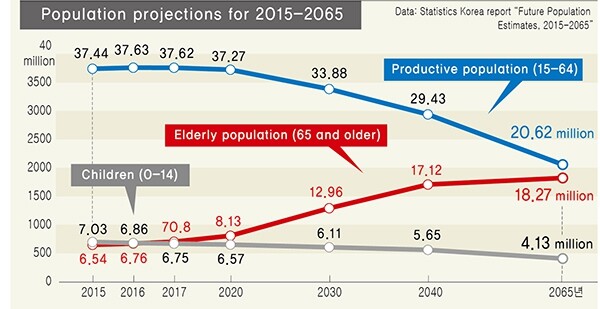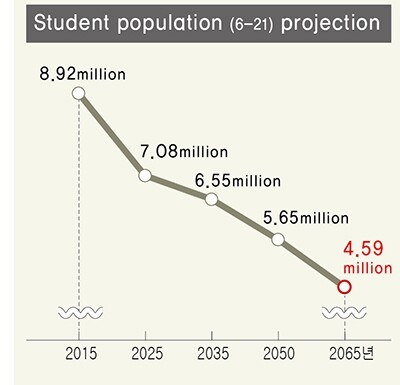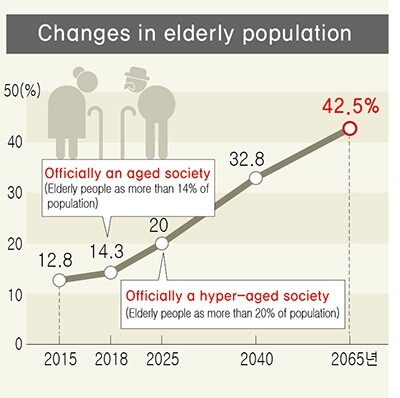hankyoreh
Links to other country sites 다른 나라 사이트 링크
Next year, South Korea will have more elderly people than children

South Korean elderly people are poised to outnumber children as of next year. The productive population is in decline. Studies have estimated the low birth rate will result in the number of students from kindergarten to university will fall by around 20% over the next ten years. It’s a change in demographic structure that is likely to have substantial effects across South Korean society.

Statistics Korea reported these findings in its “Future Population Estimates, 2015-2016” report released on Dec. 8. Published once every five years, the estimates are an indicator to forecast the future population in light of factors that affect it, including births, deaths, and migration. They are an essential reference when estimating future pension fund and government finances or the potential economic growth rate, and a basis for forming economic, demographic, and fiscal policy.
According to the estimates, the productive population aged 15-64 is set to peak this year at 37.63 million and begin declining as of 2017. By 2020, when the baby boom generation born between 1955 and 1963 become senior citizens, the productive population is set to fall by an average of 340,000 each year; by 2030, the decline is predicted to be 440,000 a year.

As of next year, the senior citizen population aged 65 and older will outnumber children aged 14 and under. The elderly population is expected to rise by 320,000 from this year to 7.08 million, while the number of children is predicted to fall by 110,000 to 6.76 million over the same period. As the senior population continues climbing sharply, South Korea is expected to become an aged society (14% or more of the population aged 65 and older) by 2018 and a hyper-aged society (20% or more) by 2025 - a year ahead of schedule from an estimate made five years ago.
The decline in the child population is also predicted to impact the school-age population, which is expected to fall from 8.92 million in 2015 to 7.08 million by 2025, and under 6 million by 2050.
“One of the big findings in these estimates is the large decline in the school-age population within ten years,” said Statistics Korea population trend bureau chief Lee Ji-yeon, adding that the drop is “about 160,000 larger than in the estimates made five years ago.”
By Kim Kyung-rok and Kim So-youn, staff reporters
Please direct questions or comments to [english@hani.co.kr]

Editorial・opinion
![[Column] Has Korea, too, crossed the Rubicon on China? [Column] Has Korea, too, crossed the Rubicon on China?](https://flexible.img.hani.co.kr/flexible/normal/500/300/imgdb/original/2024/0419/9317135153409185.jpg) [Column] Has Korea, too, crossed the Rubicon on China?
[Column] Has Korea, too, crossed the Rubicon on China?![[Correspondent’s column] In Japan’s alliance with US, echoes of its past alliances with UK [Correspondent’s column] In Japan’s alliance with US, echoes of its past alliances with UK](https://flexible.img.hani.co.kr/flexible/normal/500/300/imgdb/original/2024/0419/2317135166563519.jpg) [Correspondent’s column] In Japan’s alliance with US, echoes of its past alliances with UK
[Correspondent’s column] In Japan’s alliance with US, echoes of its past alliances with UK- [Editorial] Does Yoon think the Korean public is wrong?
- [Editorial] As it bolsters its alliance with US, Japan must be accountable for past
- [Guest essay] Amending the Constitution is Yoon’s key to leaving office in public’s good graces
- [Editorial] 10 years on, lessons of Sewol tragedy must never be forgotten
- [Column] A death blow to Korea’s prosecutor politics
- [Correspondent’s column] The US and the end of Japanese pacifism
- [Guest essay] How Korea turned its trainee doctors into monsters
- [Guest essay] As someone who helped forge Seoul-Moscow ties, their status today troubles me
Most viewed articles
- 1[Column] The clock is ticking for Korea’s first lady
- 2Samsung barricades office as unionized workers strike for better conditions
- 3[Correspondent’s column] In Japan’s alliance with US, echoes of its past alliances with UK
- 4After 2 months of delayed, denied medical care, Koreans worry worst may be yet to come
- 5[Column] Has Korea, too, crossed the Rubicon on China?
- 6Hong Se-hwa, voice for tolerance whose memoir of exile touched a chord, dies at 76
- 7US overtakes China as Korea’s top export market, prompting trade sanction jitters
- 8All eyes on Xiaomi after it pulls off EV that Apple couldn’t
- 9[Photo] Smile ambassador, you’re on camera
- 10[News analysis] After elections, prosecutorial reform will likely make legislative agenda